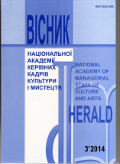СМИСЛОВІ СВІТИ ЕКРАННОЇ КУЛЬТУРИ
Semantic worlds of screen culture
Author(s): Adriana SkorykSubject(s): Anthropology, Communication studies
Published by: Національна академія керівних кадрів культури і мистецтв
Keywords: code; sign; reflection; media; image; performance; image; reality;
Summary/Abstract: Sign as the perception of the image and the horizon of its operation – spatiality with the way some of the elements. Proportionality portrayed and perceived as depicting the reality experienced. Sensation and reflection allow highlighted "experience in the reflection." The elements of fragmentary lose vision for the vision of a horizontal reliefs. Intuition captures the essence of the veracity of the fact of presence. Each code contains meaningful signs. They can assess the examination, an external analysis for reducing meaningfulness. This phenomenon with images and displaying bear a double burden of code: granted logic and sensibility is not available. Therefore, search perception is achieved through specific patterns of things and circumstances of things.Lokalization and contemporary cultural globalization make space for thinking, perception. This tool is an example of intercultural communication phenomenon of international information space. The value system has become part of the information fields. This particular form of knowledge about the world updated categories of thinking of human consciousness. This contributes to the definition of individual identity, promising future.Market logic requires activity and appreciation, evaluation of screen product. In this case continued debate about the primary and secondary evaluation of some of the facts: art appreciation analysis yields economic expertise rating calculations. Social types of consumers are also heterogeneous: for example, housewives or amateur detective.Screen Art has the ability to perceive reality in terms of space time, date, prospects, etc. This point is the basis of certain knowledge, its real factuality.Screen culture parallel to the development of computer technology, it is synthesizing the core philosophical and psychological techniques in the process. Addiction to virtual means not only the ability to move, and its ability to define independence. This workspace will be located in the commemorative resources. Virtuality of aliveness of the screen production process raises the tone of our understanding of the product. Philosophical thought favors in this regard through expressive means. Challenges and prospects make screen art relevant, surrounded by inquiring turnover. This feeds the moment of "screen reflections" that offer opportunities for virtual communication and simulation. The value of the products associated with moments of actualization of the virtual. Objectivity of "screen text" simulated reflection of real life in it, so come up real directions in art. Activity screen product mediocrity characters and symbols is its virtual reality. Form-screen product actually affects the nature of signs and symbols that are involved in the creative process. "Missing" screen that does not light, is able to negate the image simultaneously losing field iconic forms.The advent of the television signal is "technical" symbolic united modern. New technologies, new film, new photography, and hence the new value.Information technology, putting people to a new level with no spatial boundaries, is integrating national information space in a single stream. These realities have taught viewers to modell images by electronic means. Simulacrum is a copy of reality that never existed (according to J. Bordiyyarom). Simulacrum does not simulate postmodern trends in culture, the lack of reality precludes comparable acts. Item of televirtuality in the TV shows takes primary role as a substitute for the missing event-reality, that is a simulacrum. This raises the problem of identity.Screen Arts dictates life forms. "Pictures" with bright colors and "mosaic" of presentation sometimes become predominant convincing along with the realities of life. It shows televirtuality selfishness. Paul Vyrylo emphasized that the age threshold will be two realities: the actual and the virtual. Today, new technologies aimed at creating a more compelling than actual reality. Current state of the media is injected into a virtual person mode: impact on society has been restructuring methods and forms of influence on society. Create a character-forming simulacra models, which person and society would be filled with symbolic and symbolic reality. Living surrounded by symbols and signs creates a virtual essentially human.
Journal: Вісник Національної академії керівних кадрів культури і мистецтв
- Issue Year: 2014
- Issue No: 3
- Page Range: 175-180
- Page Count: 6
- Language: Ukrainian

